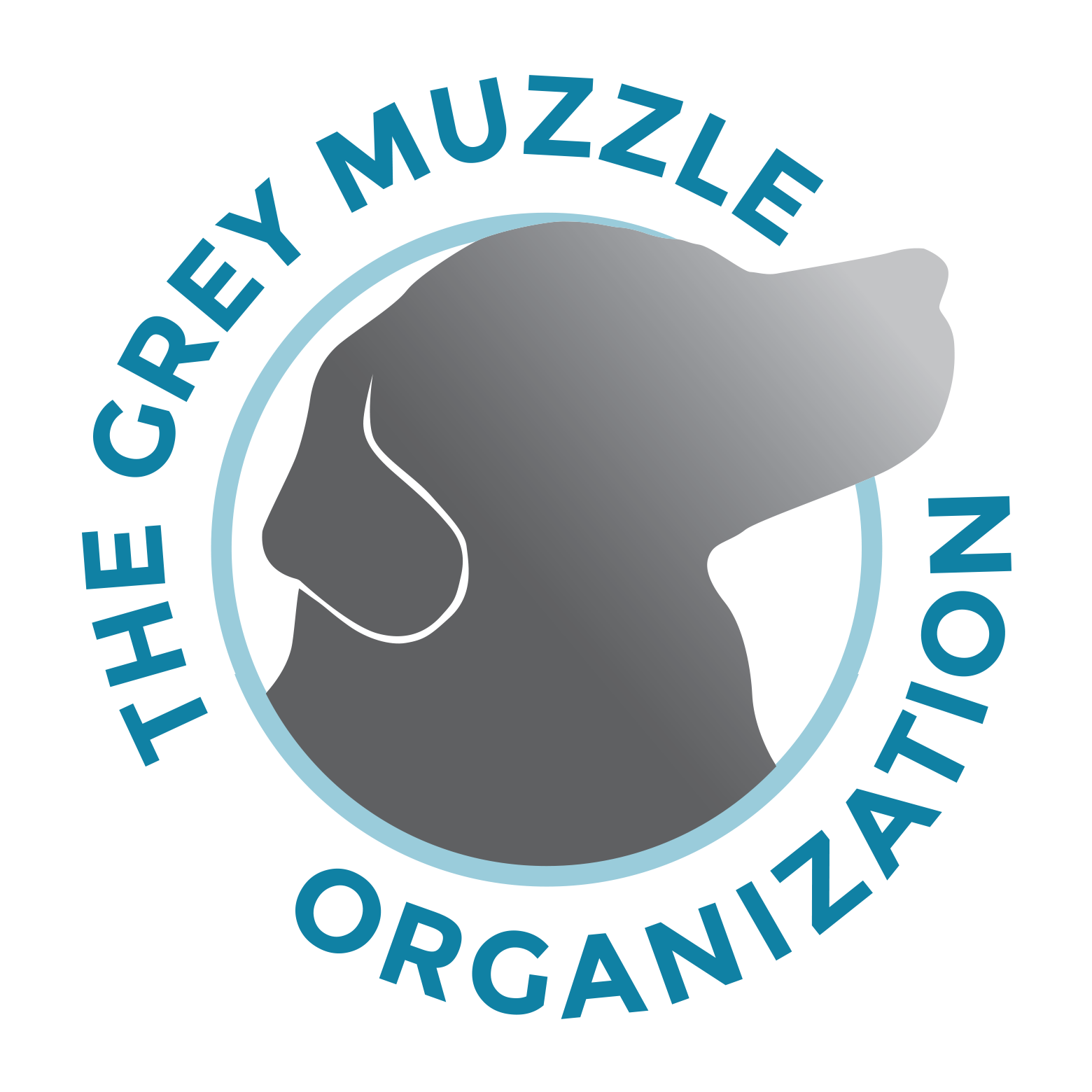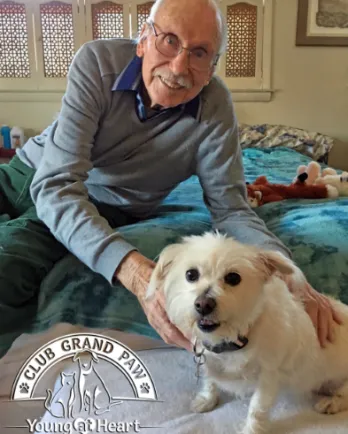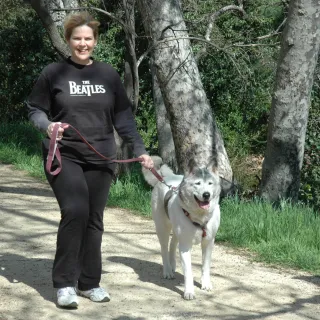Young at Heart’s “Club Grand Paw”™
“Senior dogs have always spoken to me.” It’s Friday morning and Dawn Kemper, co-founder of Young at Heart Senior Pet Adoptions in suburban Chicago, is running a mile a minute, multitasking, seeing to every detail as she readies the rollout of the rescue’s new program, Club Grand Paw, the latest embodiment of the organization’s mission “to rescue and rehome senior dogs and cats, to educate the public on the benefits of adopting older pets and their care, and to reduce the euthanasia rate for adoptable senior pets.” Despite myriad distractions, she is focused and animated when talking about both the new initiative and the organization as a whole, which has been serving senior pets in the Chicago area since 2005.
She is passionate about senior dogs.
As with many rescues, the impetus for Young at Heart (YAH) arrived in the form of a particular animal—in this case, a 5-year-old Corgi named Maddie who was abandoned in a horse barn by a breeder who didn’t want to deal with her “advanced age” and juvenile cataracts. Kemper and a friend worked together to take Maddie in, finance her vaccines and spay surgery, and find her a loving home. Soon thereafter, the idea for YAH came into focus. However, long before that, Kemper knew she was destined to work with seniors.
“Senior dogs are special,” she explains. Prior to starting YAH, she worked at an animal shelter, where she interacted with potential adopters who came bearing a list of requirements. Based on their needs, she would introduce them to a dog who was house-trained, low-key, good with children, loving . . . only to see them balk when they found out the dog was older. “It was amazing to me they couldn’t see past the age,” Kemper says. She became somewhat of a specialist in senior dogs at the shelter, advocating for them and doing her best to place them. Potential adopters, however, were concerned about the dogs’ health and the amount of time they would have with them. Ultimately, it became clear to Kemper that to successfully place senior dogs, YAH would need to allay these fears. So she set out to systematically anticipate and address the reasons people shy away from adopting an older dog.
“When we started, there were no resources for senior dogs in the Chicagoland area,” Kemper says. “Zero.” At that time, the rescue took in dogs 5 years and older because the need was so great, and they did basic vetting because that’s what they could afford. Now, they are open to dogs 7 years and older, all of whom receive full veterinary work-ups, including dental procedures, blood work, and specialist visits for those who are older or who have health issues, such as Grade III heart murmurs or kidney problems. None of this is cheap, of course (which is why the group’s fundraising is continuous, creative, and community-driven), but it’s essential that adopters have confidence in their new companions’ health.
Another fear addressed by YAH’s adoption program is what will happen to an animal if the owner’s circumstances change because of illness or disability. For several years, YAH offered a traditional “Senior to Senior” program, waiving the adoption fee for adopters over the age of 70, in an effort to place senior pets with senior citizens. “The adopter was always enthusiastic, and as an additional ‘safety net’ feature to ensure the dog would be cared for, we would also interview family, friends, or neighbors that the adopter identified as their support system,” Kemper explains. These people signed a contract committing them to help with tasks such as vet and groomer visits, trips to the pet store, etc., and agreed that should it become necessary due to the health of the adopter, the dog would be returned to YAH. Unfortunately, more often than not, the “safety net” people didn’t follow through, and dogs were returned to YAH even though the senior adopter—and the senior dog—were heartbroken to lose each other’s companionship.
About the time that YAH was rethinking the “Senior to Senior” program, an 88-year-old gentleman named Bill contacted them. He had been turned down repeatedly by other rescues and shelters as simply too old to care for an animal, and he had no one to help him, as his family lived across the country. Still, he was determined to adopt. After speaking with him at length about his lifestyle, it became clear that the perfect dog was already in the YAH foster program—a difficult-to-place 8-year-old Maltese named Blanca who liked peace and quiet and needed a home without children or other pets. “They hit it off immediately,” Kemper says, and so, with Bill’s at-first grudging consent, the Club Grand Paw™ pilot program was launched.
Through Club Grand Paw™, two specially trained volunteers check on Bill and Blanca weekly and ensure that they have everything they need—from transportation to vet, groomer, or pet supply store, to help with animal behavioral issues. As an independent senior, Bill was initially hesitant to have weekly visits, but the visits soon became a high point for all—Bill, Blanca, and the volunteers. The organization has depended on Bill to provide feedback and advice, which has helped them fashion Club Grand Paw™ into a program they feel is now ready for primetime. With seed money in the form of a grant from Grey Muzzle, Club Grand Paw™ will gradually increase the number of senior dog/cat-human partnerships to 30 by its one-year anniversary.
The three volunteer teams, who will help roll out the program to the public in early 2018, were drawn from YAH’s robust roster of volunteers, and they are being trained to respond to situations likely to arise with seniors, both human and animal. For example, when Bill was hospitalized, his volunteer team immediately took Blanca in, which was a great relief to him. They even brought her to the hospital to visit! Kemper says that Bill’s daughter, who lives many states away, was convinced that his main motivation to get stronger and leave the hospital was the little dog waiting for him at home.
In most cases, the dogs that YAH takes into their foster-based program are facing death in an open admission shelter, and one objective in launching Club Grand Paw™ was to save the lives of more senior animals. Young at Heart is currently building an adoption facility that will allow them to respond more often to desperate families looking to rehome senior pets after a family member’s death or transfer to a nursing home, as well as to save more of the legion of adoptable dogs facing uncertain futures in Chicago area shelters.
“These dogs have spent their entire lives in a home, and suddenly they find themselves in a strange place. It’s loud. It’s scary. It’s traumatic.” And yet, she says, there is typically a minimal adjustment period once they’re adopted. “I think they know that they’re safe. It’s warm, they’ve got a bed and a yard and a family, and they adapt very quickly to their new home.”
Home. Like the hundreds of dogs YAH has placed in the last dozen years. Like Bill and Blanca, who, Kemper says, “were meant for each other.”
Designing—or Redesigning—Your
Seniors-for-Seniors Program
If your organization is planning to implement a Seniors-for-Seniors program, or is evaluating and hoping to improve an existing program, it may be helpful to review the process that Young at Heart (YAH) followed when designing Club Grand Paw™. The following steps are simplified (life rarely follows a rubric!), but they represent a general outline to keep in mind as you think about your particular organization and community.
- First, identify and articulate the specific problems your organization wants to address. For example, Young at Heart identified the following problems when designing Club Grand Paw: 1) Homeless senior dogs need loving homes; 2) Senior citizens want companion animals for company and comfort, yet older senior citizens living independently are denied adoption by many area shelters and rescues due to their own advanced age; and 3) Senior citizens living independently often want to adopt, and would benefit from the companionship of a senior dog, but sometimes do not have the family or friend support necessary to do so successfully.
- Then ask, “What evidence do we have that this is a problem?” Here is YAH’s answer to #2 (above): Research has proven that there are a lot of positive reasons for senior citizens to have a pet, yet Young at Heart receives calls weekly from senior citizens who have either been denied adoption or have simply been referred to Young at Heart for being “too old” to adopt from another local animal welfare organization.
- Next, determine how you plan to address the problems. In a sense, you’ll be planning backward, from your final objective to first steps. Ask yourself:
- What will our program look like when it’s fully functional? This gives your organization a goal to work toward. In YAH’s case, they knew they wanted to target older seniors in a time-intensive way.
- What resources will be necessary (including funding and staffing)? YAH applied for funding from Grey Muzzle and also planned fundraising events to raise the necessary seed money. In addition, they identified volunteers who were already dedicated to the cause, had the time and desire to participate, and were willing to undertake extensive training.
- What’s feasible for the short term? What can we do today to test the demand and program structure? YAH decided that a pilot project would yield the feedback they needed to address problems and fine-tune the program before launch.
- Finally, figure out how you will know that you are doing what you set out to do. For example: Young at Heart will demonstrate measurable results with a positive number of senior dogs placed successfully via the Club Grand Paw™ program over the course of 12 months, with an overall pilot year goal of 25 dogs placed or an average of two dogs placed per month after a hard launch of the program.
Systematic evaluation of the problems you plan to address, the solutions you hope to implement, the specific steps you need to take, and the ways you will measure results will go a long way to assuring the success of your Seniors-for-Seniors program.
The Grey Muzzle Organization improves the lives of at-risk senior dogs by providing funding and resources to animal shelters, rescue organizations, sanctuaries, and other nonprofit groups nationwide.



